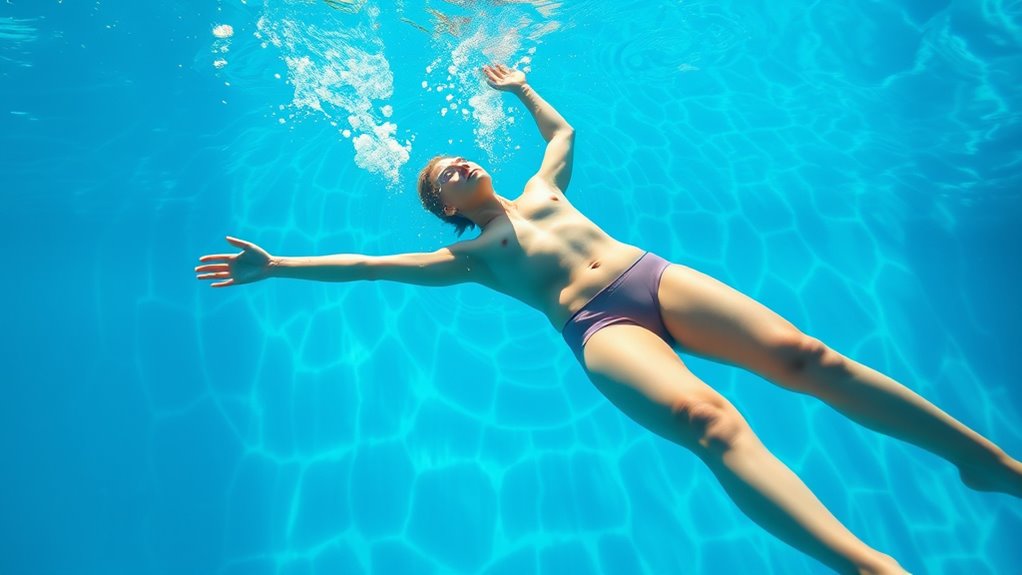Floating at the right temperature helps relax your muscles by keeping your skin comfortable and minimizing thermal stress. The sensory deprivation eliminates distractions like sound and sight, encouraging your nervous system to switch into a calm, rest-and-digest mode. The buoyant water supports your body, reducing resistance and muscle tension. Over time, this promotes deeper relaxation, flexibility, and stress relief. Keep exploring to discover how these effects can lead to lasting muscle and mental well-being.
Key Takeaways
- Floating in warm water reduces thermal stress, allowing muscles to relax naturally without temperature distraction.
- Sensory deprivation minimizes external stimuli, signaling the nervous system to shift toward relaxation mode.
- Buoyancy eliminates gravitational pull, easing muscle strain and promoting effortless stretching and relaxation.
- Prolonged floating enhances circulation and reduces muscle tension, supporting long-term muscle health.
- Controlled temperature and environment optimize comfort, increasing the effectiveness of muscle relaxation techniques.

Floating and muscle relaxation are powerful techniques that can help you reduce stress and improve overall well-being. When you immerse yourself in a float tank or pod, the water temperature plays a vital role in how effectively your muscles relax. Ideally, the water is set to a temperature close to your skin’s surface—around 93.5°F to 97°F—so you don’t feel the need to actively heat or cool your body. This near-constant temperature minimizes thermal stress, allowing your muscles to naturally release tension without the distraction of temperature discomfort. When the water temperature is just right, your muscles can sink into a state of complete relaxation, as your body doesn’t have to work to maintain its core temperature. This gentle environment creates an ideal setting for muscle fibers to unwind and reset.
Optimal water temperature (93.5°F to 97°F) promotes natural muscle relaxation and minimizes thermal stress during floating sessions.
The concept of sensory deprivation is central to understanding how floating influences muscle relaxation. When you float in a tank filled with Epsom salt-rich water, your senses are considerably diminished—no sight, sound, or tactile stimuli to distract or excite your nervous system. This sensory deprivation signals your body to relax deeply because your brain isn’t processing external stimuli that could trigger stress or muscle guarding. Without these distractions, your nervous system shifts toward a parasympathetic state—sometimes called the rest-and-digest mode—where muscle tension naturally decreases. The calm environment encourages your muscles to release built-up tension, reducing stiffness and promoting flexibility.
As you lie in the float tank, the sensation of weightlessness further enhances muscle relaxation. The buoyant saltwater supports your body evenly, eliminating the gravitational pull that usually causes muscles to contract and fatigue. This feeling of weightlessness allows your muscles to stretch and relax without resistance, which can be difficult to achieve during everyday activities. Over time, this alleviation of muscle strain can improve circulation, ease chronic pain, and reduce the likelihood of muscle spasms. The combination of ideal water temperature and sensory deprivation creates an environment where your muscles are free from external stressors, enabling a profound state of calm.
Additionally, research indicates that high-quality projectors with precise temperature control can optimize comfort during extended sessions, further enhancing muscle relaxation. The deep relaxation facilitated by controlled water temperature and sensory deprivation isn’t just about feeling good in the moment; it’s about fostering long-term physical and mental resilience. As you become more accustomed to these sessions, you’ll notice your muscles becoming more relaxed and your stress levels decreasing, making floating a powerful tool for maintaining muscle health and emotional balance.
Frequently Asked Questions
Can Floating Help Reduce Chronic Muscle Tension?
Yes, floating can help reduce chronic muscle tension. When you float, the buoyancy minimizes pressure on your muscles, promoting relaxation and increasing muscle flexibility. This tension release allows your muscles to unwind naturally, easing tightness and discomfort. As you experience less tension, your overall muscle health improves, making it easier to move freely and feel more comfortable. Floating offers a gentle, effective way to target lingering muscle tension and promote long-term relaxation.
How Often Should I Float for Optimal Muscle Relaxation?
You should aim to float about once a week to maximize relaxation benefits. Think of each session as a reset button for your muscles, releasing built-up tension and calming your mind. Regular float frequency helps your muscles stay relaxed, reducing stress and promoting overall well-being. By making floating a weekly habit, you create a soothing routine that continually supports your muscle relaxation and mental clarity.
Are There Specific Floating Techniques for Targeted Muscle Relief?
Yes, you can use specific floating techniques to target muscle relief. Focus on deep tissue relaxation by gently moving through the water, applying light pressure to tense areas, and visualizing tension release. Try slowly stretching or massaging particular spots while floating to enhance relaxation. These methods help to loosen tight muscles and promote overall tension release, making your float session more effective for targeted muscle relief.
Does Floating Benefit Muscle Recovery After Intense Workouts?
Yes, floating benefits muscle recovery after intense workouts by reducing muscle tension. Float therapy helps relax your muscles deeply, easing soreness and speeding up recovery. When you float, the buoyancy minimizes pressure on your muscles and joints, promoting better blood flow and nutrient delivery. This relaxation not only alleviates tension but also enhances your overall recovery process, making float therapy an effective addition to your post-workout routine.
Are There Risks of Muscle Strain From Floating Sessions?
There are minimal risks of muscle strain from floating, especially if you keep water temperature comfortable and limit session duration. If the water’s too cold or too hot, your muscles might tense or become overstressed. Also, prolonged floating can cause fatigue or stiffness. To avoid strain, stay within a recommended session length, listen to your body, and guarantee the water temperature is just right for your comfort and safety.
Conclusion
As you float effortlessly in the water, imagine a gentle wave washing away tension, leaving your muscles soft and free. The weightless embrace of the float is like a lullaby for your body, soothing every fiber into relaxation. When you emerge, you’ll carry that calm with you, like a peaceful river flowing through your day. Embrace the tranquility, and let floating be your secret escape to muscle serenity—your personal oasis of calm amid life’s storm.









